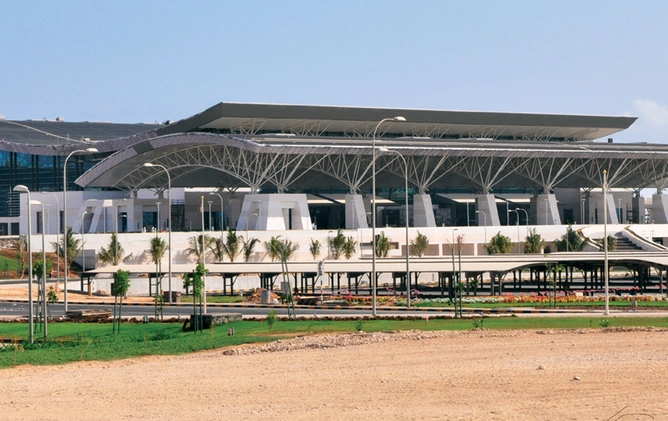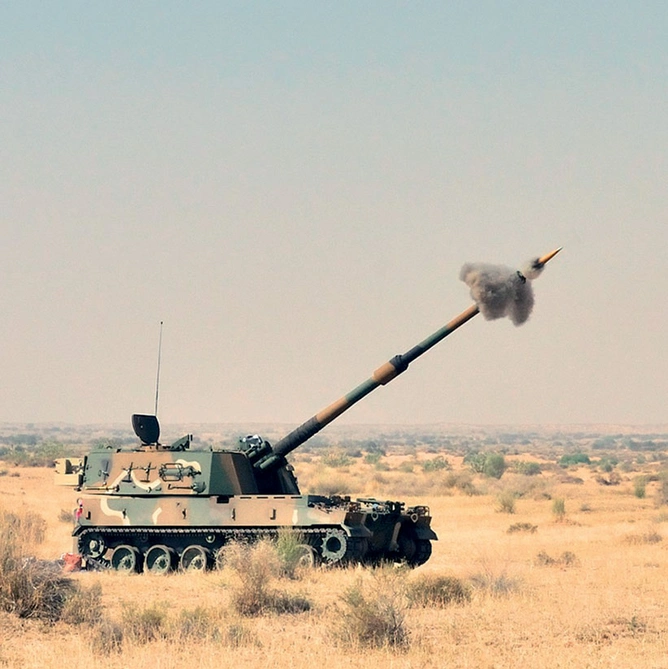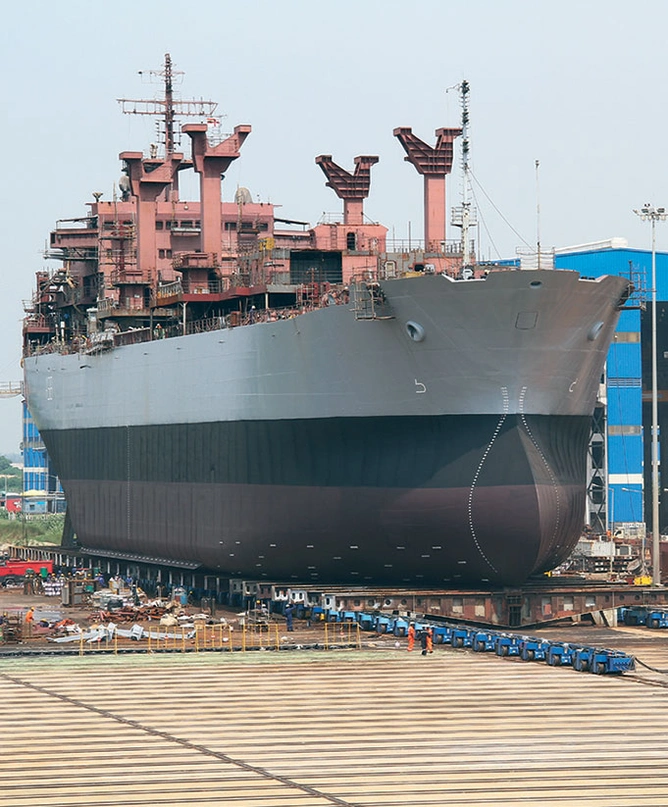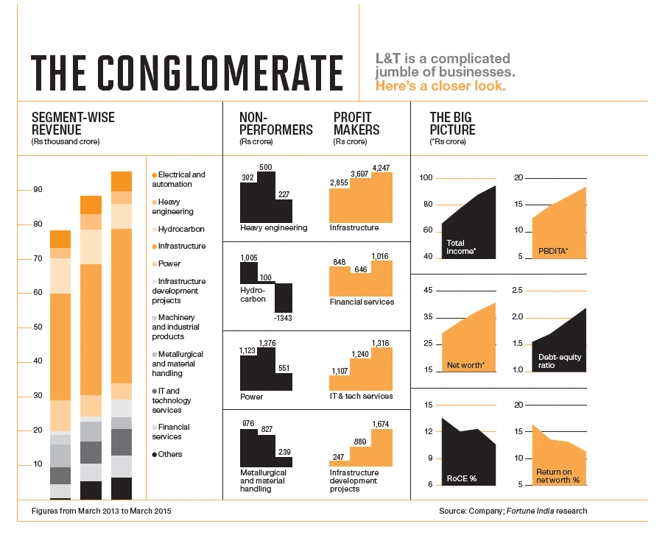The silence is deafening. I’ve just asked S.N. Subrahmanyan, deputy managing director and president, L&T, if he’s ready to fill the large shoes of the legendary group executive chairman, A.M. Naik. I had met Naik in Mumbai a couple of days ago, and he told me he has been grooming Subrahmanyan for the top job. Except, it seems, someone forgot to send the Chennai-based successor that memo. Had he been wearing a tie, I can easily imagine him loosening the knot to breathe easier. “The chairman is very kind,” comes the weak reply a few frozen moments later. “Frankly,” he says after a while, “I have never thought through the succession issue because Naik’s legacy is something very difficult to match.” It’s not that Subrahmanyan (company insiders call him SNS) is a dark horse in the race to succeed Naik; within the company, he has been seen as one of the handful of Naik protégés. And of all the heirs in waiting, he’s the bookies’ favourite, having got five promotions in as many years, and running L&T’s biggest business—his engineering and construction business contributes nearly 55% to the company’s total revenues of Rs 1 lakh crore. “I have been mentoring him for the last 10 years,” Naik tells me.
In some of what he says, and in several of his plans for L&T’s future, it’s clear that Subrahmanyan has internalised his mentor’s teachings. He often speaks in the plural; it’s more “we” than “I”, where the plural refers to Naik and him. That said, the overwhelming impression I get is that of a man trying to create his own identity. It’s a tough job, given Naik’s larger-than-life persona—Deepak Parekh, chairman, Housing Finance Development Corporation, India’s leading housing finance company, describes him as Mr Infrastructure—but Subrahmanyan is a worthy bet.
Also Read: The man who won't slow down
Naik considers himself, in many ways, a co-founder of the company he joined in 1976 and has seen grow some 2,000 times. “Now, if I try to emulate him in that sense, it won’t be possible and I will trip right on the first wire,” says Subrahmanyan, with no sign of forced humility.
By naming Subrahmanyan, a 55-year-old civil engineer with a management degree, as his successor, Naik is sending a strong message to the markets: L&T is back to business as usual, and will not face a rocky transition when he steps down in September next year. It’s an important message at this point, since analysts have been getting jittery about the stock. Broking house Religare has a “hold” rating on L&T but has cut target price from Rs 1,550 to Rs 1,200; the trigger for this is the lower-than-expected third-quarter results. Other brokerages have also advised caution, pointing out that never before in its history has L&T revised its order inflow guidance down for three successive quarters and its ability to meet even its order guidance in this fiscal. Not everyone is as pessimistic; brokerage Prabhudas Lilladher maintains a buy rating “given the potential the company has once the turnaround sets in”, but does not fail to express concern about the three quarters of poor guidance. The bottom line: L&T is undoubtedly in some trouble.

The genesis of this is in what Naik did some six years ago. He announced that he was going to split L&T into nine verticals and six subsidiaries which would together run over 150 businesses. Naik’s big idea then was to create independent group companies that could take autonomous decisions. “The point is to reduce the complexity of the organisation,” he had told me when I met him back in March 2011. “The board will now act as an investor, deciding which vertical will get what amount of money, and not work as an operator any more.”
It was a good idea—in theory. Practically, what Naik loves to call India’s GE was suffering because senior management was spread too thin. Also, as Santosh Yellapu, senior research analyst, infrastructure, Angel Broking, says, the company transformed into an asset-heavy one “by getting into major road, metro, and other projects that required huge capital investment”. The idea was to make big bucks off government contracts—which did not materialise. Delays in environment and other clearances compounded by a bad global economy, the slowdown in China, a poor domestic economy, and anaemic order inflows meant that most L&T companies began to flounder.
Government policy, which L&T hoped would work in its favour, has actually pushed the company deeper into hot water. Nobody says this on record, but some of this is seen as Naik’s failure. As the chief of one of the biggest infrastructure players in the country, Naik should have been able to lobby for more business-friendly policies. But since he has never minced his words regarding inefficiencies of bureaucracy or government, he hasn’t been winning friends in high places. A few months ago, for instance, he told the media that Prime Minister Narendra Modi’s much-vaunted economic revival “is not happening on the ground”. He specifically expressed his disappointment over the lack of progress in shipbuilding and highway projects.
L&T’s shipbuilding division, confesses Naik, has “been losing money like hell”. He blames successive governments for reneging on their promises to encourage the private sector. (What does he really think of the present government, I ask. “The captain is superb, the team is still not strong enough,” he says.) Dangling the carrot of government contracts before it, L&T was asked to build a modern port and shipbuilding facility at Kattupalli near Chennai. Anticipating juicy contracts, along with a government subsidy, the company went ahead with construction.

But even before work was complete, the government withdrew the subsidy it had offered on all shipbuilding contracts to private companies. The subsidy was a crucial part of L&T’s calculations when it studied the profitability of this project, and its abrupt withdrawal hit hard. The shipbuilding business recorded an operating loss of Rs 208 crore in 2014-15, though this was an improvement from a loss of Rs 497 crore a year earlier owing to the completion of a few projects.
Realising that its limited experience in running ports was not helping matters, the company decided to exit port operations. It has already sold its Dhamra port in Odisha to the Adani group for Rs 2,500 crore. The Kattupalli port will also likely be sold to the same group once regulatory issues are sorted. It decided to stop manufacturing commercial ships as well, while selling off the existing ones. “But these will have to be sold at a discount because the shipping industry is in a deep recession and 200 similar types of ship are lying in stock elsewhere. So we will make heavy losses in FY17,” says Naik.
There’s still some optimism, though, as Naik hopes to bag some large defence contracts. The government has placed a few orders for small interceptor boats and other small craft, but the big deals will start flowing when the country’s ageing naval fleet is modernised. The company has already bid for four warships and hopes to convert at least two, worth Rs 2,500 crore. It will vie for 16 additional ships when bidding opens in the third quarter of the financial year. L&T is one of the frontrunners for these bids, as Kattupalli is among the country’s more modern and state-of-the-art shipyards. If it wins even two contracts, the yard will be kept busy for six years.

But here’s the rub: Under the new defence procurement policy, the government has restricted a company to manufacturing only in one of 10 broad areas. For L&T, which is present in almost the entire defence supply chain, from missiles to artillery systems to naval weapon systems, this is a huge setback. In shipbuilding specifically, the procurement policy makes a distinction between above-water and below-water vessels; any company can build either submarines or ships. L&T does both.
Like the shipbuilding division, Subrahmanyan has to take hard calls on a number of other businesses because L&T continues to be a highly complex, difficult-to-manage organisation. Perhaps for the first time in its history, its fiscal strength is also under a shadow. L&T has delayed paying vendors; there were murmurs it owes vendors in the region of Rs 18,000 crore. I ask chief financial officer R. Shankar Raman (once spoken of as Naik’s successor) how L&T managed to accumulate so much as outstanding. He rubbishes the market estimate, but refuses to tell me exactly how much is owed. “If our outstanding from our own customers is around Rs 20,000 crore, then the amount payable to vendors cannot be more than Rs 8,000 crore to Rs 9,000 crore,” is all he says. According to its December quarter investor presentation, “deferred payment liabilities” stood at Rs 11,040 crore.
The company’s troubles run deep. In 2014-15, the power division saw a 60% fall in profits while the hydrocarbons unit reported operating losses of Rs 1,128 crore, and the metallurgical and material handling division saw operating margins fall to 10.6% from 16.6% a year earlier.
There’s little the company could have done to arrest the free fall in oil prices, from nearly $102 in June 2014 (Rs 6,443 at current rates) to nearly $40 a barrel in March, but it dried up orders for heavy reactors for processing plants, refineries, and petrochemical plants. Some of L&T’s projects in West Asia, one of its key markets, also turned sour because of what Subrahmanyan calls the “company’s inability to properly execute the projects, failure to understand client specifications, and sometimes picking up wrong partners”.
In the metallurgical business, a turnaround will take two years, says Naik, once steel companies are confident that they will be protected from the Chinese onslaught by an anti-dumping duty introduced on certain steel products last September, and their own balance sheets, currently under huge stress, begin improving.
Similarly, the infrastructure development projects arm, which undertakes large scale public-private partnership projects, has been making serial losses, though Naik hopes for a quicker recovery here. “It has proved itself a drag on profit for the past 15 years, but the current losses of close to Rs 600 crore can be brought down to Rs 100 crore by this September,” says Naik, shortly before adding, blunt as ever, that he should have closed the business much earlier.
It’s not that the company hasn’t acted. It has started a cost-cutting exercise, reducing overheads and laying off 25% of its employees. It has factored in another 10% to 15% cut in headcount in the next few months. It has also appointed global consulting firms Bain and McKinsey to help cut operating costs. “These measures in L&T Special Steel and Heavy Forgings, for instance, will cut losses from the current Rs 250 crore to Rs 300 crore to Rs 100 crore to Rs 120 crore in the next two years, which is manageable,” says Naik.

According to reports, the company also aims to raise $1 billion by selling off assets. Last year it sold a $200 million stake in L&T Finance to Bain Capital; a few days before we went to press, it also shed its stake in L&T Infocity for Rs 191 crore. Naik predicts that all these steps will help the company chart a new growth trajectory by 2018-19.
That’s characteristic Naik ebullience, something that seems to rub off on his colleagues too when they argue about the overall state of L&T’s finances. “Sales have been growing year on year, the Ebitda margin has been steady ranging between 9% and 13% depending on the crests and troughs in the economy, the order book is a healthy $40 billion, and we have been declaring profits and dividends since 1951,” contends CFO Raman.
But shrinking employee cost and operating expenses can only go so far. Its investor presentation points at a debt load of over Rs 1 lakh crore, against a net worth of Rs 43,260 crore. “Of course I’m worried about the poor performance of certain businesses in the current environment. But I can also see the company’s future and know what is in store at the end of the tunnel,” says Naik. Is there a time frame? “By the time I retire, I would have resolved most of these issues,” he says.
Here’s the thing. He is 73, and may not be able to keep his earlier punishing 18-hour daily schedule. Naik admits that he’s slowing things a bit; these days, he only works 12 hours a day.
Subrahmanyan may not have many of Naik’s characteristics, but he seems to have inherited the optimism. “While in hindsight one can easily find many faults with [the faltering] projects, they have also been a great learning opportunity. Our ability to mobilise workers, understand specifications, deal with contractors and clients in an equal manner, and justify our position has improved considerably,” he claims.
The issue of Naik’s successor has been a vexing one, not unlike what many other legacy companies have had to face when it was time for the towering patriarch at the helm to move on. I had grilled Naik about it in 2011, a year before he was supposed to retire, and asked why it was so difficult to find a replacement. A very testy Naik pounded on the table (causing my recorder to fly off) and proclaimed that he had found leaders for all of L&T’s group companies but making the big appointment was a hairy task. “If you can get someone who’s started 60% of the company’s business, knows every corner of L&T, who prepares a balance sheet for every hour of work that he’s done, I will make him chairman,” he had snapped.
Ravi Uppal, now managing director and group CEO of Delhi-based Jindal Steel & Power, was then tipped to take over, but that didn’t happen. The year after, Naik gave himself a five-year extension. He got the retirement age raised to 75 years, and stayed on as chairman, a move that resulted in much talk of corporate governance laxities.
Naik may well have been grooming his successor even then, but Subrahmanyan can be anointed as such only after the L&T board ratifies his promotion. Most in the industry, and many who know Naik outside it, say this is just a formality.
What could be Subrahmanyan’s one big challenge in the role? He is widely considered a man in a hurry. He gets impatient if his phone calls are not answered upon the first ring. He talks fast, almost staccato, and takes decisions almost as quickly. Even as he was telling me his plans to revive L&T, he heard one of his juniors recommend an architect for redoing the Henning Holck-Larsen Centre in Chennai, a museum dedicated to the memory of L&T’s founding father and chairman emeritus. In less than a minute, he asked the junior to get in touch and offer the architect a job. How will such a person manage the intricate—and slow—dance of bureaucracy that is woven into the job of a leader of any large company?

The answer may lie in Subrahmanyan’s discipline. He rarely misses office, and despite travelling almost 20 days a month, keeps up a fitness routine. More important, he has been a prolific performer within the company. He secured engineering, procurement, and construction contracts for four major international airports in India, at Bengaluru, Hyderabad, Delhi, and Mumbai, as well as the Salalah Airport in Oman; and construction contracts for landmark buildings like the ICICI Bank headquarters and National Stock Exchange in Mumbai, and HITEC City and HITEX Exhibition Centre in Hyderabad. During his tenure, the construction division has grown from Rs 100 crore to Rs 50,000 crore in 34 years.
I press him to name the one project dearest to him. Rather than do that, he says he’ll name the division that holds the key to L&T’s future. That’s technology, in the form of L&T Infotech and L&T Technology Services. Subrahmanyan is convinced that this division can do for L&T what Tata Consultancy Services did for the Tata group. “These companies, which are already $1.3 billion in size, can grow exponentially because they have no boundaries and little fixed costs,” he says. Naik hopes to list L&T Infotech in a much-awaited Rs 2,000 crore IPO this year.
Technology is at the heart of Lakshya 2021—the company’s strategic five-year growth plan that will be unveiled on June 1. “We will be the technology leaders in our businesses and will be a technology-led company that will focus only on cutting-edge, high-tech, and extremely complex projects—space first, nuclear second, defence third, and smart cities finally—that few other companies will attempt,” says Naik. Even the engineering and construction division will look at complex projects and not just at the next level of construction.

Subrahmanyan gets really passionate when he talks of the new tech business, Smart World Communications. He believes this business will propel L&T as a key player in a sector dominated by the likes of Cisco and Juniper. He is convinced that L&T has a lead over other players in three areas: security solutions, smart communications, and smart infrastructure.
In security solutions, L&T has bagged a project to set up a security system for Mumbai. “We have completed the South Mumbai leg of the project and plan to finish it for the entire city by the end of the year,” says Subrahmanyan. In the smart communication space, there’s a contract for laying 19,000 km of optic fibre cables to connect defence establishments in the western and southern parts of the country. The aim is to provide a separate channel of communication for the armed forces which will free up spectrum for the private telecom operators. L&T has also bid for the Bharat Broadband scheme that envisions connecting virtually all the villages, panchayats, talukas, and towns through an optic fibre network of nearly 2 lakh km. “If we get some part of the deal, it will be a huge jump in revenues for the division,” says Subrahmanyan.
Also Read: Is it time to rejig L&T?
In the smart infrastructure space, L&T has won a contract from the government of Rajasthan to make Jaipur a smart city. “In my view, it is the first example of smart infrastructure, and in a sense, it changes the way people look at governance,” Subrahmanyan says. “This is an area where L&T has great potential to grow since we are already building infrastructure,” adds Naik. “When India moves to a digital future, L&T will be ready with the capability and commitment to build a smart world.”
TECHNOLOGY WILL NOT BE L&T’s only big play. There’s also defence. Naik entered the defence and aerospace businesses nearly 30 years ago given their immense potential. Jayant V. Patil, who now leads the divisions, says there’s much room for growth. Patil says L&T is likely to win an order for the Rs 4,800 crore K9 VAJRA-T howitzer field gun, developed with Samsung. The gun has already met most of the army’s specifications and is undergoing field trials. The company has also snagged an order to build submarines with the Russians. “The defence business will be 10 times the size [nearly Rs 10,000 crore from Rs 1,000 crore to Rs 1,200 crore today] in the next five years,” says Naik bullishly.
It’s clearly a hobby horse that Naik loves riding. Defence, he tells me, may well be the flavour of the day, but not everyone has the expertise. Anyone can build a factory, he booms. “But how to use the factory is the real question.” Most companies are naive about defence, he says. They seem to believe that manufacturing complex defence equipment will somehow take care of itself once policies are in place. It’s not like making “chana murmura”, he says scornfully; “a person who doesn’t know how to make nuts and bolts has got 20 companies in defence.”

So, I ask, what will it take for Indian companies to get up to speed? “It will take at least one decade for Indian industry to develop the competence to come up to a point where imports can be brought down to 20%,” is the categorical reply. Subrahmanyan seems more circumspect than his boss about L&T’s chances. “We are serious contenders for some big defence programmes. However, the government has to give the orders, we have to be lucky enough to get the orders, and finally those orders have to fructify. It is not as easy as it seems.”
Jeena yahan, marna yahan, iske siva jana kahan. Naik sings this to me in his powerful voice when I ask what his post-retirement plans are. Loosely translated, the song from the film Mera Naam Joker means “Live here and die here; where else is there to go?” It’s one of Naik’s favourites, and like Raj Kapoor in it, he says, “[L&T] is my circus where I will live and die, because even after retirement, the company will always live within me.”

He holds a tune well, but when I tell him that, he laughs and says there are other things that he does better. When I ask his wife, Gita, about Naik’s single-minded focus on L&T, she sounds resigned. “I was a second wife to him. L&T was his first,” she says. “If I am reborn,” says Naik, when I ask if he regrets putting family second, “I would still remain as devoted to the company as I am today, but yes, I would give more time to my family.”
This is a side of Naik I’m seeing for the first time—the regretful father, the absent-minded husband, the doting and emotional grandfather. He chokes up when he tells me about the death of a beloved granddaughter, and says that many people thought she was in her grandfather’s mould. I’m more used to the Naik most business journalists know—hot-tempered, aggressive, emphatic, tough. I’m not used to the head of one of India’s largest conglomerates telling me in shocked tones that he had three new suits made and they cost him Rs 82,000. It’s “capital expenditure”, he tells me, horrified that clothes can cost so much.
I repeat my question about life beyond the corner office, and Naik produces a roll of blueprints. He is in the process of building a Vedic school in a mango grove in Valsad, Gujarat, and a hospital wing in his village Endhal in Gujarat’s Navsari district. He is also building a wellness centre in Powai, Mumbai. He has pledged 75% of his stock options in L&T to fund these activities.

So, like many corporate leaders, does he want to be remembered for his philanthropy? “I want to be remembered as a leader who helped L&T remain independent, ring-fenced it from hostile takeovers, and built a strong foundation for a new L&T,” he says, without thinking too hard.In doing all that, Naik also created a behemoth that threatens to become Frankenstein’s monster. L&T’s business divisions look large from an Indian point of view, but whether each of them can survive the global competitive onslaught during trying times will be a thorny question. Does Subrahmanyan have the nous to make the giant nimble?
In March 2011, Naik told me, “Great leaders are born once in a decade. You’re not going to get another Sachin Tendulkar in 50 years.” Perhaps not. I wonder, as I leave Subrahmanyan’s Chennai office, will L&T get another Naik?










Leave a Comment
Your email address will not be published. Required field are marked*